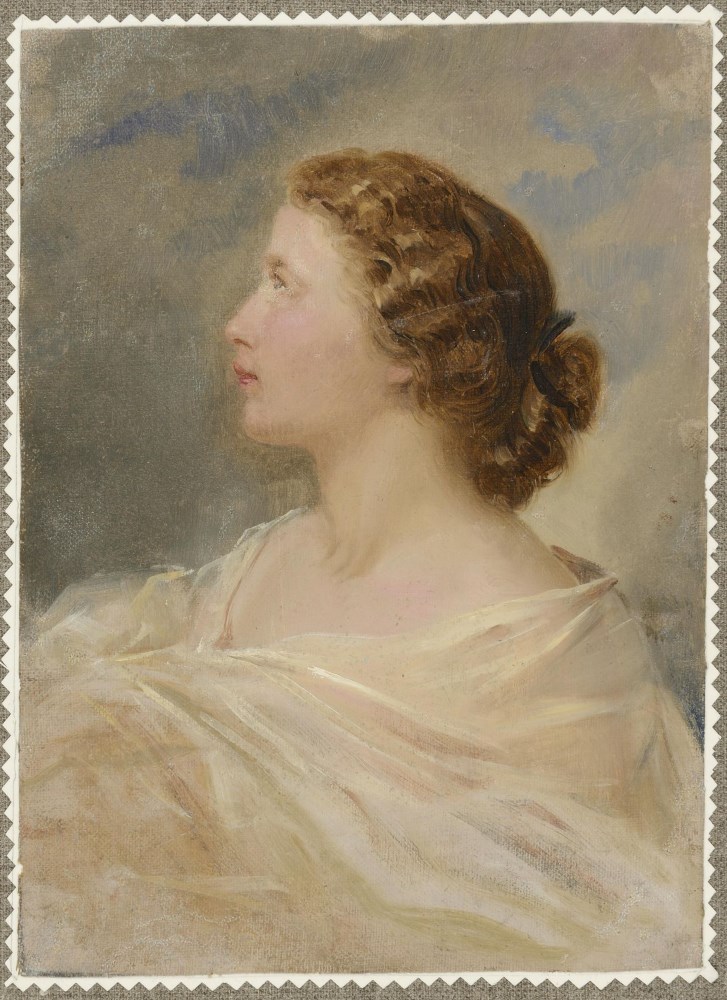Description: Constance from the Lachmans Raczyńska (1834-1874) “Deprived of parental care and peers, since the youngest years she lived her imagination, which was rich and colored with idealism. She avoided people.” [1].
Constance Raczyńska, née Lachman, was the daughter of Jerzy Lachman, a poor soldier of the tsar’s army [2] and Teresa from Potocki from Podhajec with the Pilawa coat of arms, the granddaughter of Konstancja from Potocki Raczyńska, the wife of Edward I Raczyński. Her half-sisters were Laura Świeykowska, later Marquise de Noailles, and Liza Przezdziecka. Constance grew up in Odessa. Before her death in 1841, her father put her under the care of his elder daughter from his first marriage, Laura [3].
From the Kresy, Constance quickly moved to the vibrant salons of Paris. She did not like the bustle of the city. Despite the company of imperial circles, the young girl often returned to Kamieniec Podolski to her mother Teresa’s estate [5]. “She then enjoyed the sight of the steppes, awakening memories of past battles […] She returned from there full of hope and hope that the sun of freedom will shine over the golden Podole with the sun-coat of arms when it is connected with free Poland” [6].
In Paris she met and fell in love with her uncle – Roger Raczyński, who fascinated the young relative, giving her lessons in Polish literature [4]. After about twelve years of acquaintance, in the winter of 1862 Konstancja from Lachman married the fourth owner of Rogalin properties [7]. Thus she became the stepmother of her stepson Edward Aleksander Raczyński, who was only thirteen years younger. Roger was to be loved with deep and sincere feeling. “She almost fell in love with him from the first meeting. She was fascinated by his versatile mind, philosophical inquisitiveness, originality. Even the tendency to paradoxes. She was captivated by his kindness, kindness, which was covered with cheerfulness, his compassion for human misery.” [8]. They got married in Berlin, in a very small circle of relatives. Then they moved to Rogalin. They did not have any offspring.
Lachman was extremely independent, both in terms of achieved goals and proclaimed views. She charmed with the lack of snobbery [9]. “Miss Constance, being already twenty-eight when she married, being no beauty, spread around her an extraordinary charm. Hair, like silver-gold fabric, framed the lush braid of a snow-white face animated by a blush. Small dark sapphire eyes had a look so intelligent that it seemed that it was the activity of thought […] Cheerfulness was her characteristic and with ease at every opportunity she was able to pick up the hidden comedy of a given situation, to enjoy it. “[10].
She was quickly accepted by the Raczyński family. She also gained the sympathy of the local population. She and her husband were involved in the independence activities of 1863. She supported the insurgents and their families. When Roger was on the list of those sentenced to prison, “Mrs. Roger, who in that dangerous epoch showed an extraordinary spirit of courage, foresight and energy, remained in Rogalin to guard the property and maintain contact between her husband and the country.” [11]. Wanting to join her beloved in Paris, she left the palace in Rogalin and went to Florence. Their Italian home became a meeting place for Poles who had to leave the land of their fathers. “Whoever looked into Florence had to cross the threshold of this salon and take care of pro publico bono, that is, what was at heart – to talk about the Fatherland, about the way to help the compatriots.” [12].
Like her grandmother from the Potocki, she helped her husband in his scientific work, in writing philosophical works. The texts created by him in French and German were translated into Polish by her. She also wrote herself. She expressed her thoughts mainly in poetry. She especially liked Teofil Lenartowicz. “She usually said that after a few hours of intense work, something funny should be read to enjoy it to the fullest, because laughter is a cure for the soul and body. “[13].
After the death of Roger, overwhelmed by piercing pain, she organized spiritualistic sessions [14]. She died ten years after the farewell of her beloved husband. In 1874, being in Wrocław, she fell ill with typhus. She fought it for a long time, there and in Rogalin. She spent her last moments of life alone. She hardly spoke. She was transferred to a sanatorium in Berlin, where she died [15]. She was buried next to her husband in the Rogalin mausoleum.

Author
NN, ( - )
Technique/Medium
oil/canvas
Dimensions (width/height)
16 x 22
Dating
1860
Exhibition place
Sypialnia Edwarda Aleksandra
Inventory number
MNP FR 157
Owner
Fundacja im. Raczyńskich przy Muzeum Narodowym w Poznaniu
Provenance
Dawne wyposażenie rezydencji w Rogalinie
Object's subject matter in MNP
Galeria Sztuki Polskiej koniec XVIII w. do 1939 r.

